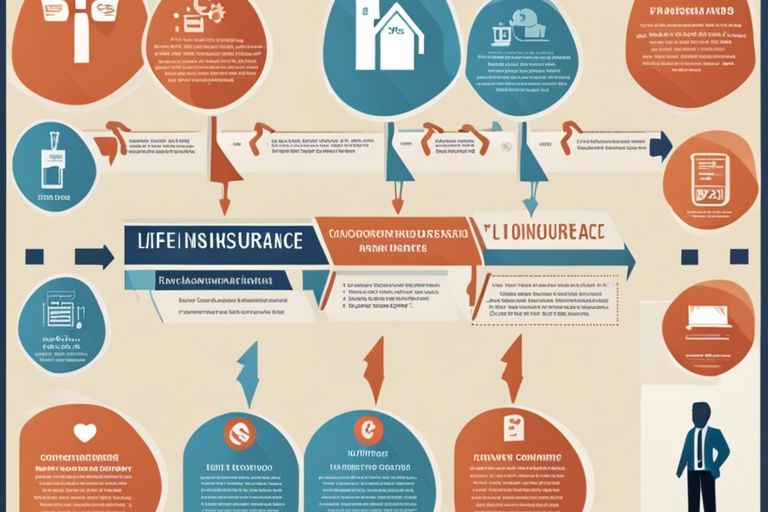Insurance is an important component of financial planning, and securing a comprehensive life insurance coverage is crucial for your peace of mind and protection of your loved ones. In this guide, you will learn the step-by-step process to help you navigate the complexities of selecting the right life insurance policy for your needs and ensuring adequate coverage for the future. From assessing your financial obligations to understanding the different types of life insurance, this guide will walk you through the important steps needed to secure the best possible protection for your family.
Key Takeaways:
- Evaluate Your Needs: Before purchasing life insurance coverage, assess your financial situation, dependents, debts, and long-term financial goals to determine the appropriate coverage amount.
- Compare Different Policies: Research and compare various life insurance policies, such as term life, whole life, and universal life, to find the one that best suits your needs and budget.
- Review and Update Regularly: Life changes, such as marriage, children, career advancements, or buying a house, may require adjustments to your life insurance coverage. It’s important to review and update your policy regularly to ensure it continues to meet your needs.
Understanding Life Insurance Types
Before delving into securing a comprehensive life insurance coverage, it’s crucial to understand the different types of life insurance policies available to you. Each type serves a unique purpose and caters to different financial needs. By knowing the distinctions between them, you can make an informed decision on what works best for your situation. Here’s a breakdown of the common life insurance types:
| Term Life Insurance | Provides coverage for a specific term, typically 10-30 years. |
| Whole Life Insurance | Offers lifelong coverage with a cash value component. |
| Universal Life Insurance | Flexible coverage with adjustable premiums and death benefits. |
| Variable Life Insurance | Allows you to invest premiums in separate accounts for potential growth. |
Term Life Insurance
Little upfront cost for a significant payout – that’s what term life insurance offers. This type of policy is ideal if you’re looking for straightforward coverage for a specific period, such as until your children are grown or your mortgage is paid off. It provides a death benefit to your beneficiaries if you pass away during the term of the policy. However, keep in mind that once the term ends, you may need to renew the policy at a higher cost based on your age and health at that time.
Whole Life Insurance
An excellent long-term investment, whole life insurance not only provides a death benefit but also accumulates cash value over time. The premiums you pay go towards both the cost of insurance and the cash value component, which grows at a guaranteed rate. The policy remains in effect for your entire life as long as premiums are paid, offering stability and financial security to your loved ones after you’re gone. The cash value can be accessed through loans or withdrawals, providing you with a financial cushion in times of need.
Whole life insurance is often used for estate planning, as the death benefit can help cover estate taxes and provide an inheritance for your heirs. It can also be a part of your retirement strategy, providing supplemental income through cash value withdrawals during your golden years. Keep in mind that whole life insurance premiums are higher than term life insurance, but the lifelong coverage and cash value accumulation make it a valuable asset in your financial portfolio.
Universal Life Insurance
While universal life insurance offers the flexibility of adjusting premiums and death benefits, it also comes with risks. The policy’s cash value varies based on interest rates and market performance, impacting the overall coverage and cash value growth. Universal life insurance is ideal for individuals who seek flexibility in their coverage and are comfortable with market-driven returns. Understanding the risks and rewards of universal life insurance is crucial before committing to this type of policy.
Variable Life Insurance
Any investment-savvy individual can appreciate variable life insurance, as it allows you to invest premiums in separate accounts managed by the insurance company. You have the freedom to choose how your cash value is invested, giving you the potential for growth based on market performance. However, with this potential for growth comes the risk of loss if the investments underperform. Variable life insurance is suitable for those willing to take on investment risks in exchange for the potential of higher returns.
Factors to Consider When Choosing a Life Insurance Policy
There’s a myriad of factors to take into account when selecting a life insurance policy that best fits your needs and circumstances. Here are some key considerations to help guide you through the process:
Age and Health Status
Life insurance premiums are typically lower when you’re younger and in good health. It’s important to consider your age and health status when choosing a policy as they directly impact the cost and coverage options available to you. If you have any pre-existing medical conditions, you may need to disclose them to the insurance provider.
Perceiving your current health status and anticipating future medical needs can help you determine the right amount of coverage to secure for yourself and your loved ones.
Income and Expenses
Clearly assess your current income and expenses to determine how much coverage you need to financially protect your family in case of your passing. Your life insurance policy should provide enough coverage to replace your income and cover any outstanding debts or expenses.
When evaluating your income and expenses, consider factors such as mortgage payments, education costs for children, and everyday living expenses to ensure your family’s financial stability in the future.
Family Size and Dependents
One of the crucial factors to consider when choosing a life insurance policy is the size of your family and the number of dependents relying on you for financial support. The more dependents you have, the higher the coverage amount you may need to secure.
Another consideration is the age of your dependents. Young children may require financial support for a longer period compared to older children or spouse who may be self-sufficient.
Debt and Financial Obligations
Income should be carefully evaluated to determine the amount of debt and financial obligations you have. This includes outstanding loans, mortgages, credit card debts, and any other financial commitments. Your life insurance policy should provide enough coverage to settle these debts and ensure that your loved ones are not burdened with financial liabilities in your absence.
Long-term Goals and Objectives
Life insurance can also serve as a tool to help you achieve your long-term financial goals and objectives. Whether it’s funding your child’s education, leaving a legacy for your family, or securing your retirement, your policy should align with your future plans.
Factors such as investment options, cash value accumulation, and policy flexibility can play a significant role in helping you achieve your long-term financial goals through your life insurance coverage.
Step-by-Step Guide to Securing Life Insurance Coverage
Not everyone fully understands the process of securing comprehensive life insurance coverage. To help you navigate through this important decision, here is a step-by-step guide to assist you in finding the right policy for your needs and ensuring financial security for your loved ones.
Research and Compare Insurance Providers
| Life | Insurance Providers |
| Research | Take the time to research different insurance providers and compare their offerings, premiums, customer reviews, and financial stability. Choose a reputable company with a strong track record of paying out claims. |
| Compare | Obtain quotes from multiple providers to compare coverage options and costs. Consider factors like the type of policy, coverage amount, premium affordability, and any exclusions or limitations. |
Determine Your Coverage Needs
While determining your coverage needs, consider factors such as your age, financial obligations, income, debts, and future expenses like college tuition or mortgage payments. Calculate the amount of coverage required to ensure your family’s financial stability in your absence.
Another important aspect to consider is the length of coverage you need. For example, you may opt for a term life insurance policy that provides coverage for a specific period, such as 20 or 30 years, to coincide with your financial responsibilities.
Choose the Right Policy Type
The type of life insurance policy you choose can have a significant impact on your coverage and premiums. Term life insurance provides coverage for a specified period, while whole life insurance offers lifelong coverage with a cash value component. Consider your budget and long-term financial goals when selecting the right policy type for your needs.
Customize Your Policy with Riders and Add-ons
Policy riders and add-ons allow you to customize your coverage to meet your unique needs. Common riders include accelerated death benefits, which provide access to a portion of the death benefit if you are diagnosed with a terminal illness, and waiver of premium riders, which waive premiums if you become disabled.
Apply for Coverage and Wait for Approval
Securing life insurance coverage involves applying for a policy, completing a medical exam (if required), and providing relevant documents. After submitting your application, the insurance company will review your information and underwrite your policy. Once approved, you can start your coverage and enjoy peace of mind knowing your loved ones are protected financially.
Understanding the Importance of Regular Policy Reviews
It is vital to review your life insurance policy regularly, especially when major life events occur, such as marriage, divorce, the birth of a child, or purchasing a home. By reassessing your coverage needs and updating your policy accordingly, you can ensure that your loved ones are adequately protected in any circumstances.
Tips for Getting the Best Life Insurance Rates
All life insurance policies are not created equal, and neither are the rates that come with them. Securing the best rates for your life insurance coverage requires some strategic planning and consideration. Here are some tips to help you get the best life insurance rates possible:
Maintain a Healthy Lifestyle
You can significantly impact your life insurance rates by maintaining a healthy lifestyle. Engaging in regular physical activity, eating a balanced diet, and avoiding excessive alcohol consumption can help lower your premiums. Additionally, you should schedule regular check-ups with your doctor to monitor your overall health and address any concerns promptly.
Improve Your Credit Score
While your credit score may not seem directly related to your life insurance rates, insurance companies often use it as a factor in determining your premiums. By improving your credit score, you can demonstrate financial responsibility and potentially qualify for lower rates on your life insurance policy. Paying bills on time, reducing debt, and monitoring your credit report for errors are vital steps to take in boosting your credit score.
Quit Smoking and Avoid Risky Behaviors
Any risky behaviors, such as smoking or participating in extreme sports, can increase your life insurance rates. Quitting smoking not only improves your overall health but can also lead to significant savings on your life insurance premiums. Additionally, avoiding risky hobbies or activities that could result in injury or death can help you secure more favorable rates for your life insurance policy.
Bundle Policies for Discounts
Getting multiple insurance policies from the same provider can often result in significant discounts on your premiums. By bundling your life insurance with other types of insurance, such as auto or home insurance, you can unlock savings and get the best possible rates. It’s vital to compare quotes from different insurers to ensure you’re getting the most competitive rates for your bundled policies.
Work with an Independent Insurance Agent
The benefits of working with an independent insurance agent are vast. The agent has access to multiple insurance carriers and can shop around on your behalf to find the best rates and coverage options that suit your needs. Independent agents can provide personalized guidance and help you navigate the complexities of life insurance, ensuring you make well-informed decisions about your coverage.
Pros and Cons of Life Insurance
Many important pros and cons of life insurance can help you understand the benefits and drawbacks of this financial product. Below is a table highlighting some key points to consider:
| Benefits | Drawbacks |
| Financial security for your family | Premium payments can be expensive |
| Income replacement in case of death | Policy can be complex and difficult to understand |
| Debt repayment for your loved ones | Policy may have limitations and exclusions |
| Estate planning and tax benefits | Coverage may not be enough for your needs |
Benefits of Life Insurance
To secure your family’s financial future, life insurance can provide a safety net in case of your unexpected passing. Your loved ones can have peace of mind knowing that they will be financially taken care of with the death benefit from your policy. Additionally, life insurance can help cover any outstanding debts you may leave behind, such as a mortgage or student loans.
Drawbacks of Life Insurance
Life insurance comes with its drawbacks as well. The cost of premiums can sometimes be high, especially if you opt for whole life or universal life policies. Understanding the intricacies of different policies can also be challenging, leading to confusion about the coverage and benefits you are entitled to.
A common complaint about life insurance is that the coverage may not always be sufficient for your needs. It’s necessary to carefully assess your financial situation and goals to determine the right amount of coverage you require.
Common Misconceptions About Life Insurance
On occasion, misconceptions about life insurance can deter individuals from obtaining this valuable protection. Some people believe that life insurance is only necessary for older individuals or those with dependents. However, life insurance can benefit individuals of all ages by providing financial security and peace of mind for their loved ones in case of a tragedy.
For instance, another misconception is that life insurance is too costly for the average person. In reality, there are various affordable options available that can provide adequate coverage based on your budget and needs. It’s necessary to explore different insurance policies and consult with a financial advisor to find the right fit for you.
Overcoming Common Obstacles to Securing Life Insurance
Affordability Concerns
If you are concerned about the affordability of life insurance, know that there are various types of policies available that can fit different budgets. Term life insurance, for example, typically offers lower premiums than whole life insurance. By comparing quotes from different insurance providers, you can find a policy that meets your coverage needs while staying within your budget.
Pre-Existing Medical Conditions
If you have pre-existing medical conditions, don’t worry – you can still secure life insurance coverage. While some insurers may be hesitant to provide coverage or may offer higher premiums, there are specialized insurance companies that cater to individuals with medical conditions. By working with an insurance broker or agent, you can find the right provider that is willing to offer you a policy that suits your needs.
It’s necessary to disclose all your medical conditions honestly and provide any necessary medical records to the insurance company. This transparency will not only expedite the underwriting process but also ensure that you receive the appropriate coverage for your medical situation.
High-Risk Occupations or Hobbies
To address concerns related to high-risk occupations or hobbies, consider working with an insurance company that specializes in underwriting these specific risks. There are insurance providers that offer policies tailored to individuals with dangerous jobs or hobbies like skydiving or rock climbing. By doing thorough research and comparing different offerings, you can find a policy that provides the coverage you need at a competitive rate.
Insurance providers may request additional information about your occupation or hobbies to assess the level of risk involved. By being transparent about your activities, you can help the insurer understand the precautions you take and potentially lower your premiums.
Age-Related Health Issues
Health concerns that come with aging can sometimes make securing life insurance challenging. However, there are insurance companies that specialize in providing coverage for older individuals. By exploring options such as guaranteed issue life insurance or final expense insurance, you can find a policy that meets your needs regardless of your age or health status.
For instance, guaranteed issue life insurance does not require a medical exam and guarantees coverage, making it an accessible option for individuals with age-related health issues. While premiums for these policies may be higher, they can provide peace of mind knowing that your final expenses will be covered.
To wrap up
Considering all points discussed, you now have a better understanding of how to secure a comprehensive life insurance coverage. Remember to assess your financial needs, research different types of policies, compare quotes from multiple providers, and consult with an insurance agent to tailor a plan that suits your specific circumstances. By taking these steps, you can ensure that your loved ones are protected financially in the event of your passing.
Additionally, it’s important to review and update your policy regularly as your life circumstances change. Keep track of major life events, such as marriages, births, or changes in income, and adjust your coverage accordingly. By staying proactive and informed, you can rest assured that you have a solid life insurance plan in place to provide for your family’s future needs.
FAQ
Q: Why do I need life insurance?
A: Life insurance provides financial protection for your loved ones in the event of your death. It can help cover funeral expenses, replace lost income, pay off debts, and ensure your family’s financial stability.
Q: How much life insurance coverage do I need?
A: The amount of life insurance coverage you need depends on your individual circumstances, such as your income, assets, debts, and financial goals. It’s recommended to have coverage that is at least 5-10 times your annual income.
Q: What factors should I consider when choosing a life insurance policy?
A: When deciding on a life insurance policy, consider factors such as the type of policy (term life, whole life, universal life), coverage amount, premiums, riders (additional coverage options), the financial stability of the insurance company, and your long-term financial goals.




